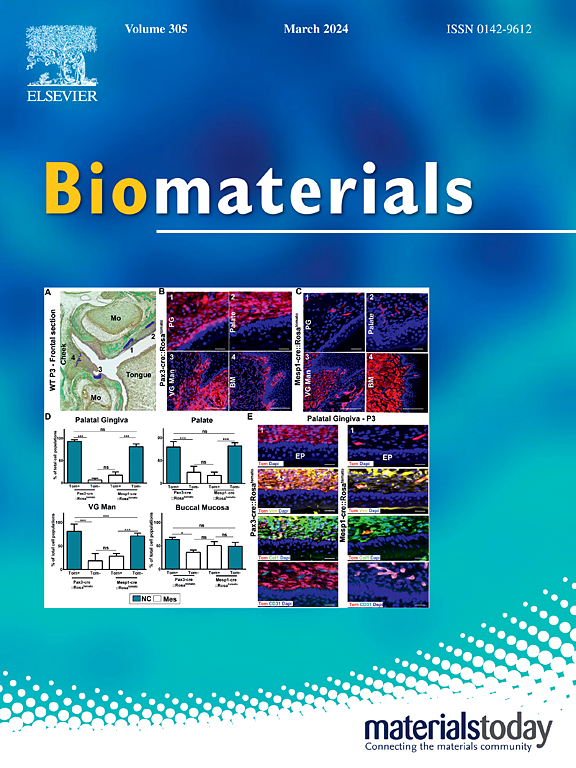Bioactive microspheres to enhance sonodynamic-embolization-metalloimmune therapy for orthotopic liver cancer
IF 12.8
1区 医学
Q1 ENGINEERING, BIOMEDICAL
引用次数: 0
Abstract
The development of novel microspheres for the combination of sonodynamic therapy (SDT) with transarterial embolization (TAE) therapy to amplify their efficacy has received increasing attention. Herein, a novel strategy for encapsulating sonosensitizers (e.g., oxygen-deficient manganese tungstate (MnWOX) nanodots) with gelatin microspheres was proposed. The obtained MnWOX-encapsulated microspheres (abbr. Mn-GMSs) facilitated efficient sonodynamic-embolization-metalloimmune therapy via the immune effects of metal ions on orthotopic liver cancer tumor after transarterial embolization (TAE). Due to the strong cavitation effect caused by the porous structure, Mn-GMSs exhibited a greater reactive oxygen species (ROS) generation rate than the free MnWOX nanodots under US irradiation. Efficient SDT revealed robust cell-killing effects and triggered strong immunogenic cell death (ICD). Moreover, the Mn ions released from the bioactive Mn-GMSs further stimulated the dendritic cells (DCs) maturation and triggered the activation of the cGAS/STING pathway to enhance the immunological effect. Thus, Mn-GMSs achieved significant SDT therapeutic outcomes in H22 tumors in mice, and the combination of the Mn-GMSs triggered SDT with programmed cell death ligand 1 (PD-L1) antibodies could further enhance therapeutic outcomes. The Mn-GMSs exhibited high ROS generation efficacy under US irradiation, significant immune activation, good efficacy in combination with immune checkpoint inhibitor, and great potential for artery embolization-assisted drug delivery, thus enabling effective destruction of liver tumors in rats and rabbits. Therefore, this work provides a strategy for applying SDT in deep tumors and highlights a promising sonodynamic-embolization therapy for combating liver cancers.
生物活性微球增强原位肝癌超声-栓塞-金属免疫治疗。
新型微球用于超声动力治疗(SDT)与经动脉栓塞(TAE)联合治疗以增强其疗效的研究日益受到关注。本文提出了一种用明胶微球包封声敏剂(如缺氧钨酸锰纳米点)的新策略。获得的mnwox包封微球(简称mn - gms)通过金属离子对原位肝癌经动脉栓塞(TAE)后肿瘤的免疫作用,促进了高效的声动力-栓塞-金属免疫治疗。由于多孔结构引起的强空化效应,mn - gms纳米点在US照射下比游离MnWOX纳米点表现出更高的活性氧(ROS)生成速率。高效SDT显示出强大的细胞杀伤作用,并引发强烈的免疫原性细胞死亡(ICD)。此外,从具有生物活性的Mn- gms中释放的Mn离子进一步刺激树突状细胞(DCs)成熟,并触发cGAS/STING通路的激活,从而增强免疫效果。因此,mn - gms在小鼠H22肿瘤中取得了显著的SDT治疗效果,并且mn - gms触发的SDT与程序性细胞死亡配体1 (PD-L1)抗体的结合可以进一步提高治疗效果。mn - gms在US照射下具有较高的ROS生成效率,具有明显的免疫激活作用,与免疫检查点抑制剂联合使用效果好,具有动脉栓塞辅助给药的巨大潜力,可有效破坏大鼠和家兔肝脏肿瘤。因此,这项工作为在深部肿瘤中应用SDT提供了一种策略,并强调了一种有前途的声动力栓塞治疗肝癌。
本文章由计算机程序翻译,如有差异,请以英文原文为准。
求助全文
约1分钟内获得全文
求助全文
来源期刊

Biomaterials
工程技术-材料科学:生物材料
CiteScore
26.00
自引率
2.90%
发文量
565
审稿时长
46 days
期刊介绍:
Biomaterials is an international journal covering the science and clinical application of biomaterials. A biomaterial is now defined as a substance that has been engineered to take a form which, alone or as part of a complex system, is used to direct, by control of interactions with components of living systems, the course of any therapeutic or diagnostic procedure. It is the aim of the journal to provide a peer-reviewed forum for the publication of original papers and authoritative review and opinion papers dealing with the most important issues facing the use of biomaterials in clinical practice. The scope of the journal covers the wide range of physical, biological and chemical sciences that underpin the design of biomaterials and the clinical disciplines in which they are used. These sciences include polymer synthesis and characterization, drug and gene vector design, the biology of the host response, immunology and toxicology and self assembly at the nanoscale. Clinical applications include the therapies of medical technology and regenerative medicine in all clinical disciplines, and diagnostic systems that reply on innovative contrast and sensing agents. The journal is relevant to areas such as cancer diagnosis and therapy, implantable devices, drug delivery systems, gene vectors, bionanotechnology and tissue engineering.
 求助内容:
求助内容: 应助结果提醒方式:
应助结果提醒方式:


